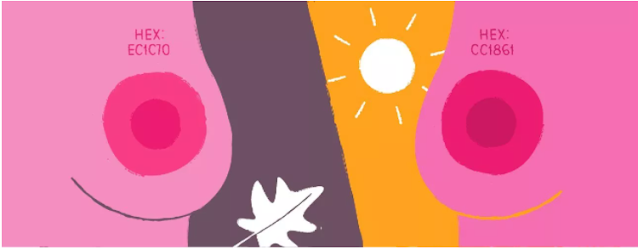She has them, he has them, some have more than one pair of them — the nipple is a wondrous thing.
How we feel about our bodies and all its working parts can be loaded, but perhaps no body part elicits quite as much mixed emotion as the breast — for both men and women.
Amid a perpetual onslaught of breast augmentation ads, boob-lifting bras, and nipple bans, it can be easy to dismiss that women’s breasts (and specifically nipples) serve more than an evolutionary purpose to feed offspring. (Of course, this doesn’t dictate if women can, should, or want to have kids.) It’s also easy to forget that male nipples might not be too different either.
And yet, nipples are as individual as we are, with all kinds of surprising quirks up their sleeve. So do yourself a little favor and get to know your nips more — even the smallest detail could be a conversation starter about health, or pleasure.
1. Women’s health used to be diagnosed via nipples
Color was a major factor doctors and nurses considered when reading into a woman’s health. In 1671, the English midwife Jane Sharp published a book called “The Midwives Book or the Whole Art of Midwifry.”
According to a Stanford course about the female body, Sharp once wrote, “The Nipples are red after Copulation, red as a Strawberry, and that is their Natural colour: But Nurses Nipples, when they give Suck, are blue, and they grow black when they are old.” Thankfully, this practice has been discontinued.
2. There are 4 to 8 types of nipples
Your nipples can be flat, protruding, inverted, or unclassified (multiple or divided). It’s also possible to have one breast with a protruding nipple and the other with an inverted, making the total combination of nipple types up to eight.
3. Your nipple isn’t your areola
The nipple is at the very center portion of your breast, and is linked to the mammary glands, where milk is produced. The areola is the darker colored area surrounding the nipple.
4. Inverted nipples are normal
Inverted nipples, which tuck inward instead of protruding out, function the same as “regular,” protracted nipples. It’s possible to have one non-inverted nipple alongside an inverted one, and it’s also possible to have inverted nipples that pop out later.
Inverted nipples tend to go away after breastfeeding a baby and won’t interfere with breastfeeding. Stimulation or cold temperatures can also temporarily cause nipples to protrude. Piercings and surgery can convert “innie” nipples to “outies.”
5. You can have two nipples on one areola
This is called double and bifurcated nipple. Depending on the ductal system, both nipples may be able to produce milk for infants. However, when breastfeeding, infants may find it difficult to fit both in their mouth.
6. Nipple hair is real
Those tiny bumps around your nipples? Those are hair follicles, which both men and women have, so it only makes sense that hair grows there! These hairs might look darker and more wiry than other hairs on your body, but you can pluck, trim, wax, or shave them the same way as other hairs, if they bother you.
7. The average nipple height is the size of a lady bug
In one 2009 study of 300 women’s nipples and areolas, results showed a mean areola diameter of 4 cm (which is a little smaller than a golf ball), a mean nipple diameter of 1.3 cm (similar to the width, not length, of an AA battery), and a mean nipple height of 0.9 cm (the size of a lady bug).
8. Breastfeeding wasn’t always the standard
Though breastfeeding is now among educated, upper-middle-class women, the same group actually used to oppose breastfeeding their babies. In the Renaissance period, aristocratic women used wet nurses to feed their offspring. And in the early 20th century, infant formula was considered ideal because its price tag was a signifier of wealth.
Since then we’ve learned that formula can never provide all the same ingredients as human milk does.
9. Nipple pain is common among women
It’s not unusual for breastfeeding moms to experience pain in their nipples for various reasons, including positioning problems during feeding. But breastfeeding shouldn’t be painful.
Experiencing pain or soreness in your nipples also afflicts non-moms, and can be a symptom of PMS or other hormonal changes, as well as:
skin irritation
allergies
friction from a sports bra
Nipple cancer is rare, but get it checked out by a doctor if your pain is persistent or you notice any blood or discharge.
10. Nipples can change in size
This happens frequently during pregnancy. One 2013 study of 56 pregnant women showed that their nipples grew in both length and width during the course of the study and their pregnancy. Their areola width also increased significantly.
11. Report all abnormal nipple discharge
Nipple discharge from one or both breasts can be an indicator of health concerns like hypothyroidism and cysts, as well as things like medication changes. But if you notice bloody discharge, be sure to have it evaluated by a doctor right away as it could be a sign of something more serious.
12. Of course, there’s an “ideal” nipple placement
According to this study which polled 1,000 men and 1,000 women, the most liked nipple-areola placement for both genders is “in the middle of the breast gland vertically and slightly lateral to the midpoint horizontally.” But that doesn’t mean your nipples aren’t ideal — the study also mentioned that nipple placement is influenced by media, where men “tend to have a more youthful breast in mind,” while women may have “more of a realistic one.”
13. Nipple tattoos aren’t uncommon with breast reconstruction
Most people have no say over how their nipples look, but the information for the study above is useful for breast reconstructive and cosmetic surgeons. Nipple-areolar tattoos are considered the final step in breast reconstruction surgery. These tattoos are growing in popularity among people who get the surgery because it’s a relatively quick and simple procedure with visually realistic results.
A nipple’s worth isn’t in how much it lactates, but in how you care and treat it because there’s no one version of “normal.”
14. There’s a rare condition that causes people to be born without nipples
This is called athelia. To treat athelia, one would get breast reconstruction. And depending on body habits and preferences, the surgeon will take tissues from the abdomen, dorsal, or glutes.
15. It’s possible to have multiple nipples
Multiple nipples are called supernumerary nipples. It’s estimated that 1 in 18 people have supernumerary nipples (in fact, Mark Wahlberg has one!), but it doesn’t stop there. One man had seven nipples: Two normal ones and five additional supernumerary ones. A 22-year-old woman even had a nipple on her foot. It had fat tissue, hair follicles, glands, and all.
There’s even one reported case of a woman who had full breast tissue and a nipple on her thigh, and it produced milk after she had her baby.
16. Nipples can chafe and crack — ouch
In one Brazilian study, 32 percent of women reported experiencing cracked nipples due to breastfeeding in the first month after giving birth. But if you’re not breastfeeding, your workout might be the culprit to red, itchy, or flaky nips.
Be sure to wear the right sports bra or protect your nipples with a little petroleum jelly to keep them from chafing against your clothes.
17. Nipple piercings can bring positive feelings
In a study from 2008 of 362 people, 94 percent of men and 87 percent of the women polled about their nipple piercings said they’d do it again — and not because piercings were a kink thing. They liked the look of it. Less than half of the sample said it was related to sexual gratification from pain.
18. Nipple stimulation enhances sexual arousal
For most men and women, nipple play is rewarding foreplay. A study and questionnaireTrusted Source of 301 men and women (ages 17 to 29) found that nipple stimulation enhanced sexual arousal in 82 percent of women and 52 percent of men.
While only 7 to 8 percent said it decreased their arousal, it’s always a good idea to ask before assuming.
19. Your nipples can change color
You may have heard to look to your nipples for your matching lipstick color, but the conclusion for this is that experts agree to disagree. Despite many other publications (from Refinery29 to Marie Claire) testing this lipstick theory, it’s not 100 percent reliable because your nipples can change color due to temperature, pregnancy, and time (it gets darker).
20. Nerves to the breast and nipple differ in men and women
Researchers in 1996 dissected cadavers to study the nerve supply to the nipple and areola. They found that the nerves spread out more widely in women than men.
21. Breast surgery can affect nipple sensitivity
Breast augmentation is an extremely popular surgery, with a 37 percent increase from 2000 to 2016. The surgery does bear risks of sensation loss. One study from 2011 found that 75 percent of women surveyed had changes in sensation after the surgery, while 62 percent experienced pain from being touched.
22. You should have bumps around your nipples
They’re called the Montgomery glands, although the scientific name is the areolar glands. These glands produce a secretion called lipoid fluid to help keep the entire areola and nipple area more lubricated and comfortable.
23. Breastfeeding women can start spontaneously leaking milk if they hear or think about their babies
For some moms, this can also happen if they hear someone else’s baby crying! Mothers whose babies are in NICU and too premature or sick to eat, have more success pumping if they have a picture of their baby near.
24. Nipples attract women, just like they attract men
A University of Nebraska study found that women and men follow similar eye patterns when looking at women: They quickly look at breasts and “sexualized parts” before moving on to other areas of the body.
25. It’s rare, but male nipples can lactate
Inappropriate lactation, also known as galactorrhea, can affect men, but it’s incredibly rare. Some experts say it’s often due to major hormone surges. Older studies in the 1970s and 80s show records of males producing milk that’s similar to lactating women, but there hasn’t been more recent studies since.
So now you know: When it comes to nipples, there’s a massive range — from bumps to size and even amount!
A nipple’s worth isn’t in how much it lactates, but in how you care and treat it because there’s no one version of “normal.” But as with any other part of your body, if you’re ever concerned about something your nipples are doing (or not doing), your best bet is to see a doctor.
Culled: Healthline















